This perfect coconut cake sets the bar for homemade cakes everywhere. It’s supremely moist with a soft fluffy crumb and intense coconut flavor. To ensure success, follow this recipe carefully including using cake flour, egg whites, sour cream, and canned coconut milk.
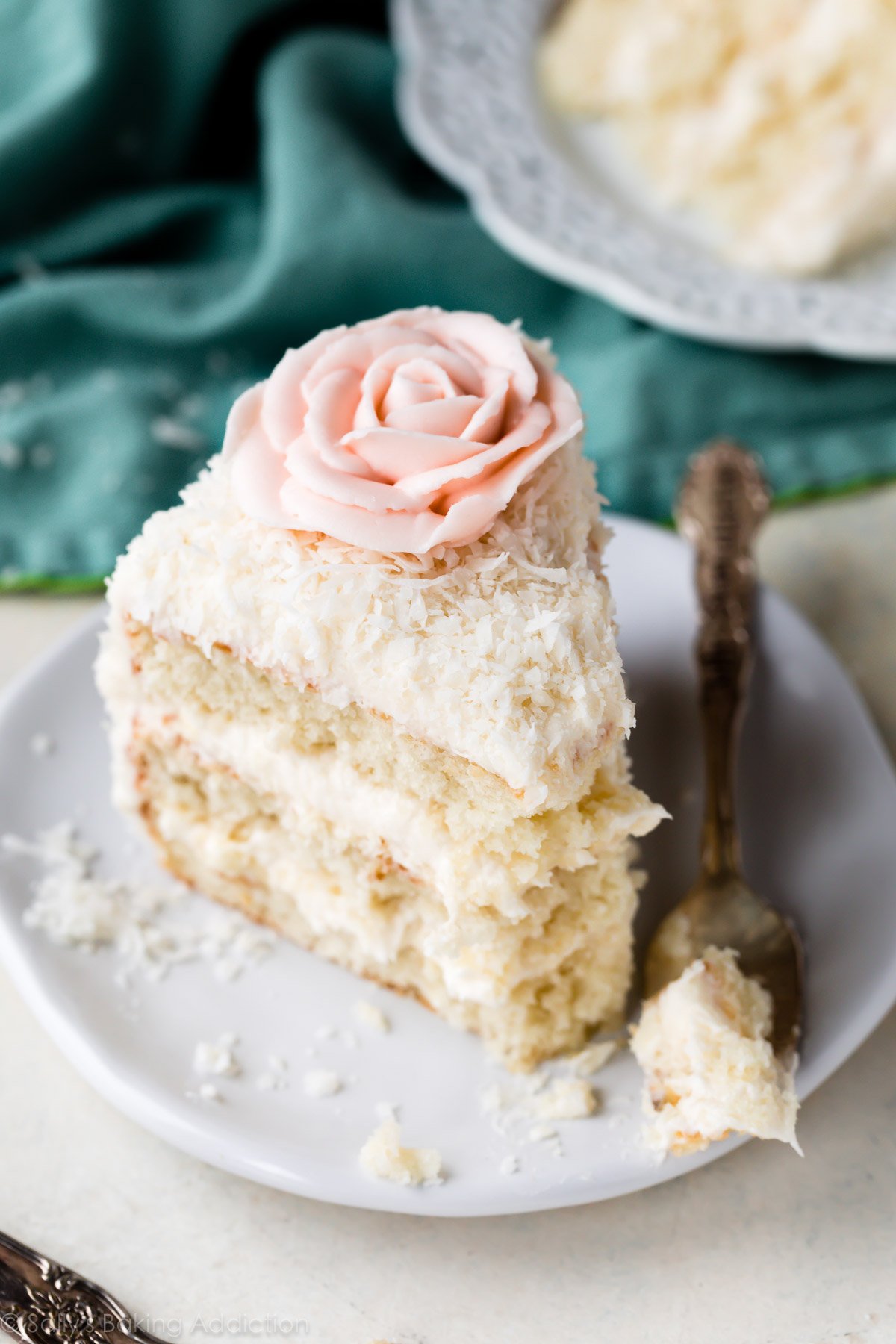
At the request of many readers, let me introduce you to the best coconut cake I’ve ever had. Homemade with love for coconut lovers everywhere, this cake exceeds my expectations. Complete with silky coconut cream cheese buttercream, she’s absolutely perfect and juxtaposes bold flavor with a light crumb.
I endlessly tested this cake recipe. In fact, I’m pretty sure my head turned into an actual coconut during the process. Is there shredded coconut caked into the crevices of my kitchen floor and backsplash? Yes.
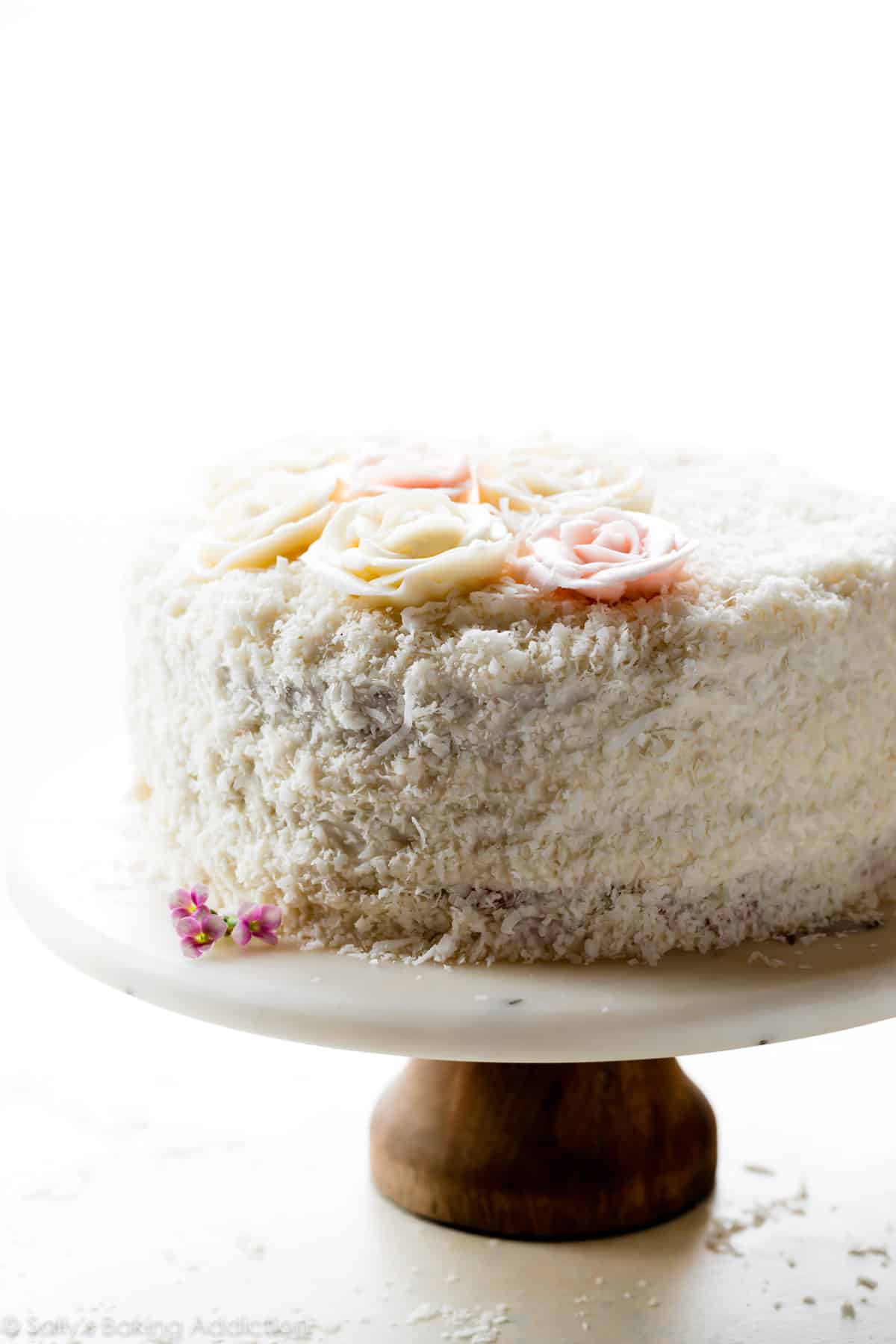
5 Reasons to Love This Coconut Cake Recipe
- Not Dry: This coconut cake is mega moist. There’s no point wasting your time (or calories!) on dry cakes.
- Intensely Flavorful: Using coconut milk, shredded coconut, and coconut extract, you are guaranteed an intensely flavorful coconut cake.
- Soft & Fluffy: By following the recipe carefully, as well as using the power ingredients described below, you are guaranteed a soft-as-silk coconut cake crumb.
- Any Shape: Use this cake batter for coconut Bundt cake, coconut cupcakes, a 2-layer cake, 3-layer cake, or a coconut sheet cake.
- Gets Along With Everyone: Use the frosting recipe below or try strawberry frosting, lemon frosting, brown butter cream cheese frosting, champagne frosting, or chocolate buttercream. Add raspberry cake filling between the layers or drizzle salted caramel on top! With so many ways to customize, this coconut cake is always a crowd-favorite when looking for Easter dessert ideas.
Coconut Cake Video Tutorial
This recipe sets the bar for homemade cakes everywhere. It’s simply exquisite and is sure to be one of your favorite spring dessert recipes and Easter brunch recipes. Talk about a show stopper!

How to Make Coconut Cake
I adapted this recipe from my favorite white cake. Its pristine crumb, fluffy texture, and stick-to-your-fork moisture guarantee cake success. In fact, I have the recipe memorized and even used it as the base of pistachio cake, cookies & cream cake, espresso cake, burnt sugar caramel cake, and strawberry cake. The recipe is cake gold and I knew it would be the perfect starting point for a fluffy and moist coconut cake.
Your coconut cake journey begins with two mixing bowls. Dry ingredients in one and wet ingredients in another (see full recipe instructions below). Combine the two in your mixer, along with coconut milk and sweetened shredded/flaked coconut. That’s it! Your coconut cake batter is ready to bake.
Creamed butter and sugar provide a solid base for this cake recipe. Use room temperature butter, and remember that room temperature is cooler than you think.
Another tip: Use all room temperature ingredients, including the eggs and sour cream. Why? Ingredients bond together very easily when they’re warmer, which creates an evenly textured baked good. Cold ingredients do not emulsify together. Period.


Use These 6 Power Ingredients
Cake is literally nothing without its ingredients and these power players are the difference between dense dry cake and light moist cake.
- Cake Flour: Cake flour produces the softest cake. If you don’t usually buy cake flour, make the exception here. It’s sold in the baking aisle with the other flours. You can use leftovers in any of these cake flour recipes. If you can’t find it, try making this cake flour substitute.
- Egg Whites: Egg yolks are wonderful for moisture, but they’re heavy and weigh down cakes. We use whole eggs in my coconut Easter cake which is much more dense, like a pound cake. To keep this coconut cake light and fluffy, use only egg whites. We’ll add the moisture back in with sour cream.
- Sour Cream: The moist maker! This cake melts in your mouth.
- Coconut Extract: I tested this recipe with and without coconut extract. We loved it both ways, but coconut extract is necessary for best coconut flavor. It’s in the baking aisle near the vanilla extract.
- Canned Coconut Milk: Canned coconut milk is a cooking ingredient, not a beverage. It’s creamier and thicker than regular milk and usually found near the Thai food products. Do not use the refrigerated coconut milk beverage that comes in a carton, because the two are very different.
- Sweetened Shredded Coconut: I recommend using sweetened shredded coconut, also called sweetened flaked coconut. It’s moister than unsweetened coconut and that makes a big difference in the cake’s texture. I reduced the added sugar in the cake batter to make up for the sweetness. Sweetened coconut is sometimes sold as long skinny shreds, a size some find off-putting in cake. Therefore, I recommend pulsing them in a food processor so they’re smaller.
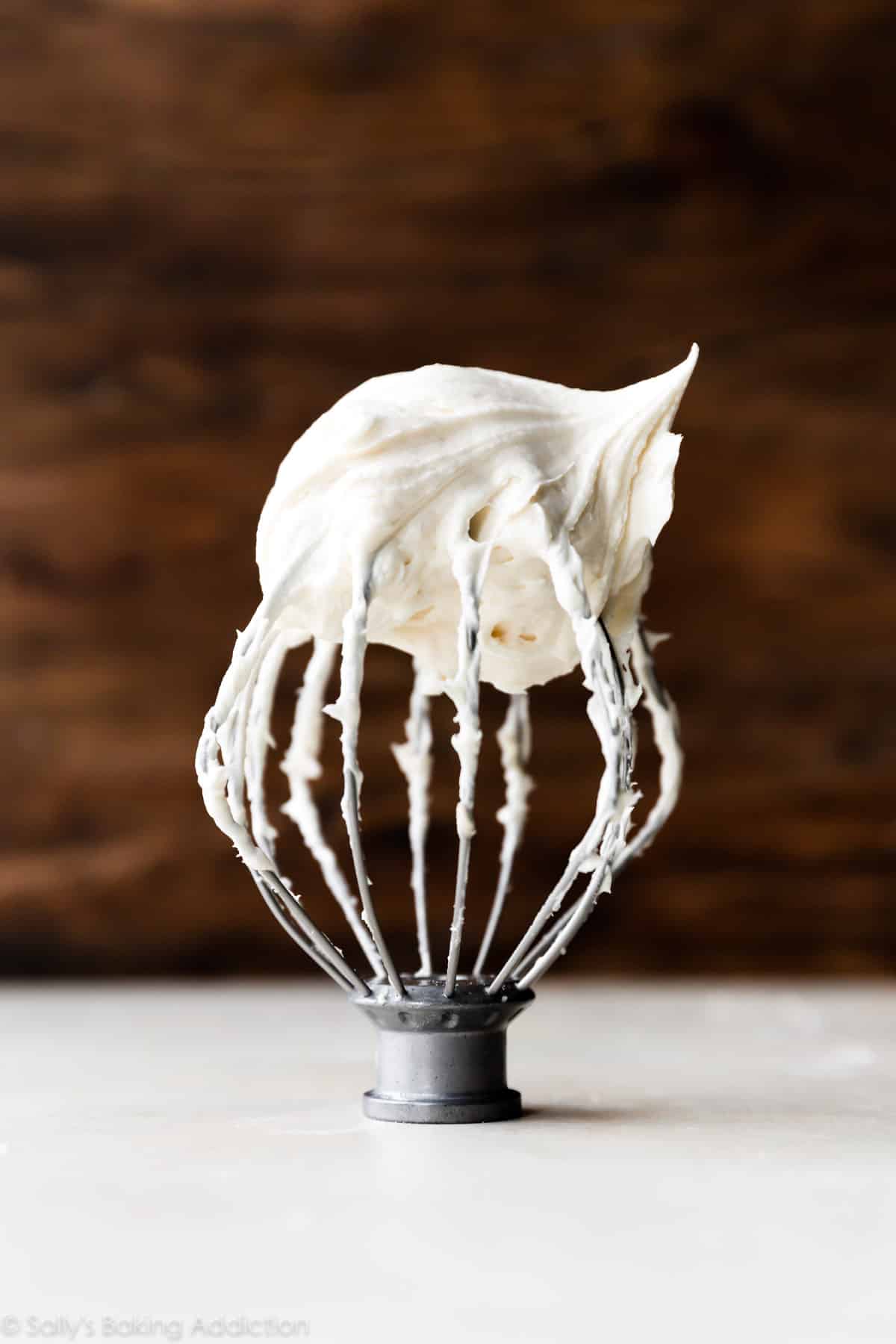
Coconut Cream Cheese Buttercream Frosting
What do you love about vanilla buttercream? It’s buttery, sweet, and smooth.
And what about cream cheese frosting? It’s creamy, silky, and tangy.
Let’s combine the two, then add coconut milk and coconut extract. It’s even creamier and silkier than the coconut frosting on these coconut chocolate Easter cupcakes so that glides onto the cake seamlessly. (Which is a happy bonus because decorating a layer cake can be quite the task. See more below.)
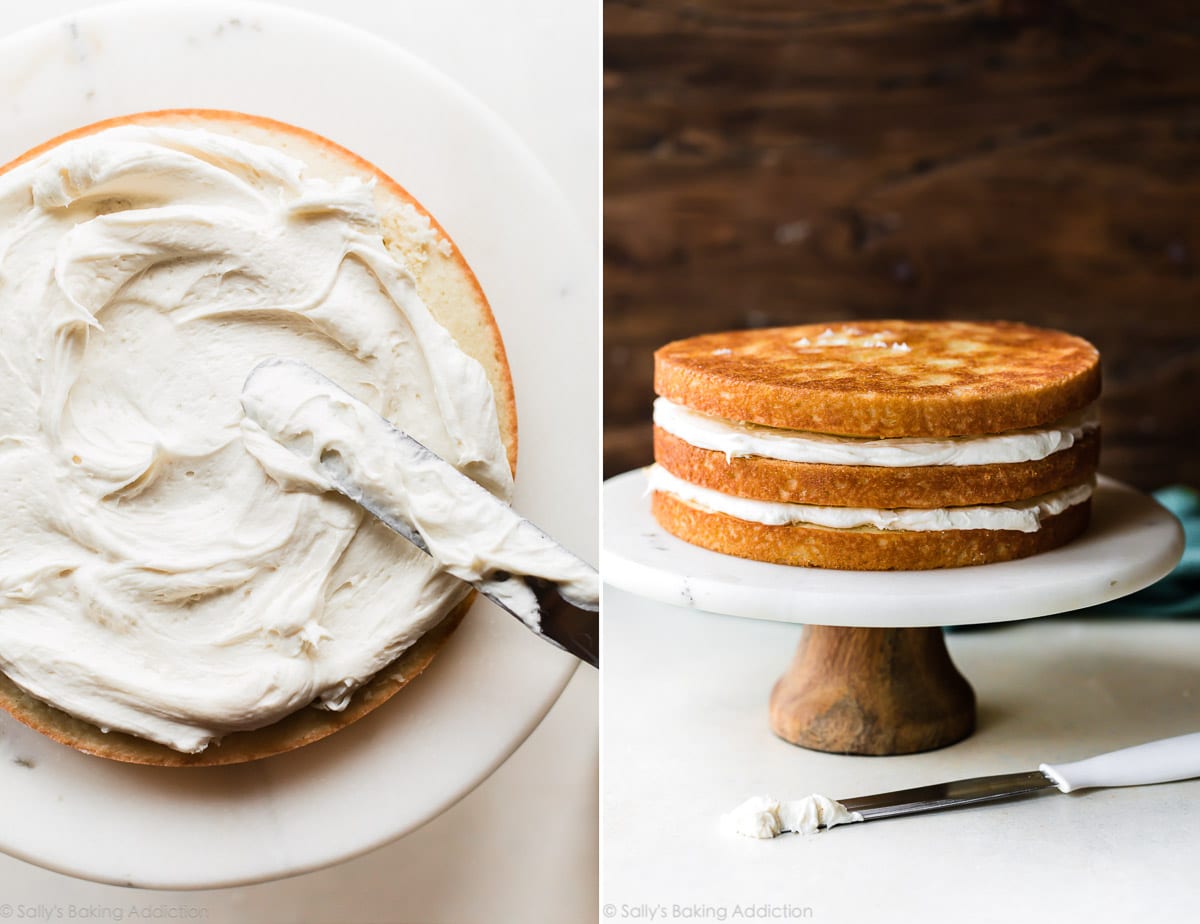
If you prefer a non-cream cheese option, use my vanilla buttercream instead—use canned coconut milk instead of milk and add 1/2 teaspoon coconut extract.
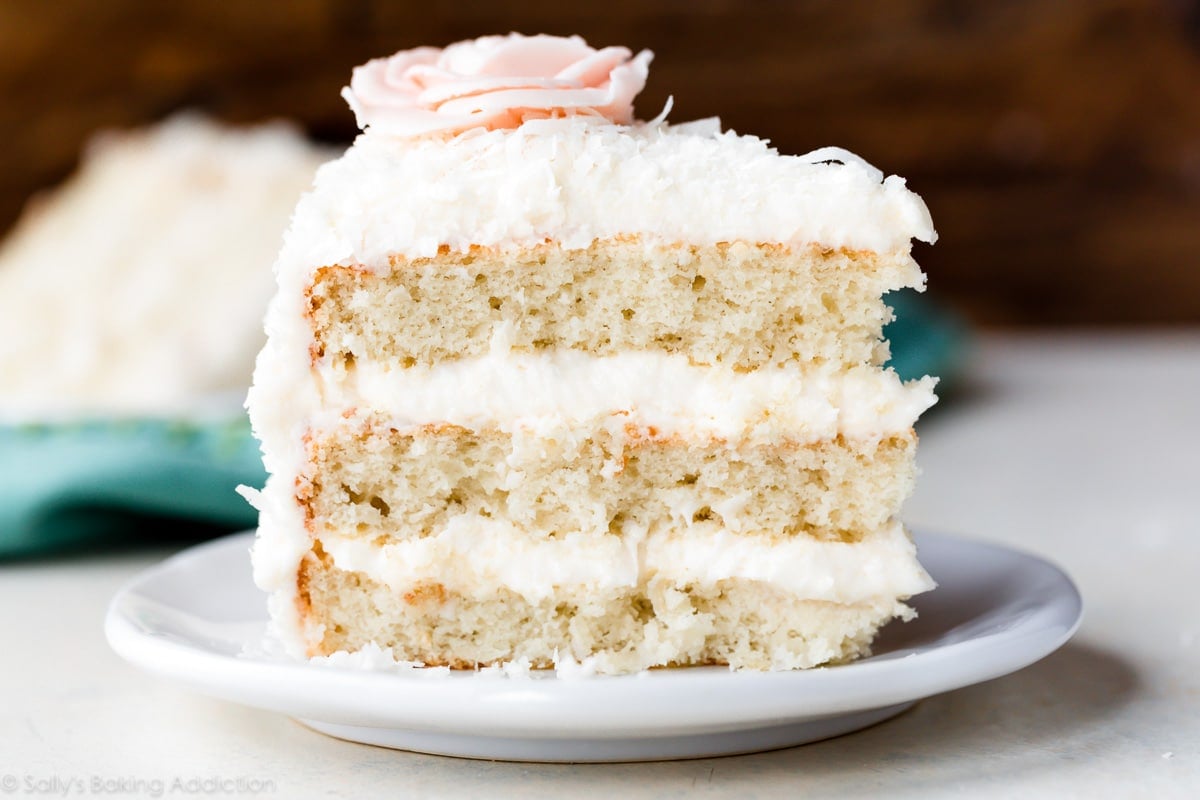
How to Frost a Layer Cake
Alright, let’s do this.
- Cool cakes completely. Sounds obvious, but even the tiniest bit of warmth will melt the frosting. As a result, the layer cake will slip, slide, or even cave in!
- If your cakes have a dome on top, level them off with a cake leveler or serrated knife. Flat-topped cakes ensure a straight and sturdy layer cake.
- Choose a serving plate, cake turntable, or cake stand. The exact cake stand I use in these pictures is no longer available, but here is a similar option.
- Place the bottom layer on the cake stand. Using an icing spatula, spread 1 and 1/2 cups of frosting in an even layer on top. Bring the frosting just over the edge of the cake; this will be helpful when it’s time to frost the sides.
- Place the second layer top-side-down on top. Make sure it aligns with the bottom cake layer.
- Spread 1 and 1/2 cups frosting evenly on top, just as you did with the bottom layer.
- Place third layer top-side-up on top. Again, make sure it’s perfectly aligned.
- Divide the remaining frosting in half. (Just eyeball it.) Dollop half of the frosting on top of the cake and use an icing spatula to smooth it to the edges. Apply *some* of the remaining frosting all around the sides of the cake, then use a bench scraper to smooth it in a thin layer. Apply the rest of the frosting on the sides of the cake, then bench scrape to smooth it all out.
- Wipe any excess frosting off of the cake stand.
You can watch me decorate this coconut cake in the video tutorial above or you can use this detailed how to assemble and decorate a layer cake post as your guide. Don’t stress; if you take your time and make sure the cake layers are totally straight, you’re all set.
But I Don’t Want to
Skip the drama and make a coconut sheet cake instead! Sheet cakes are easier to frost because they’re only one layer. See my recipe note about different size coconut cakes.
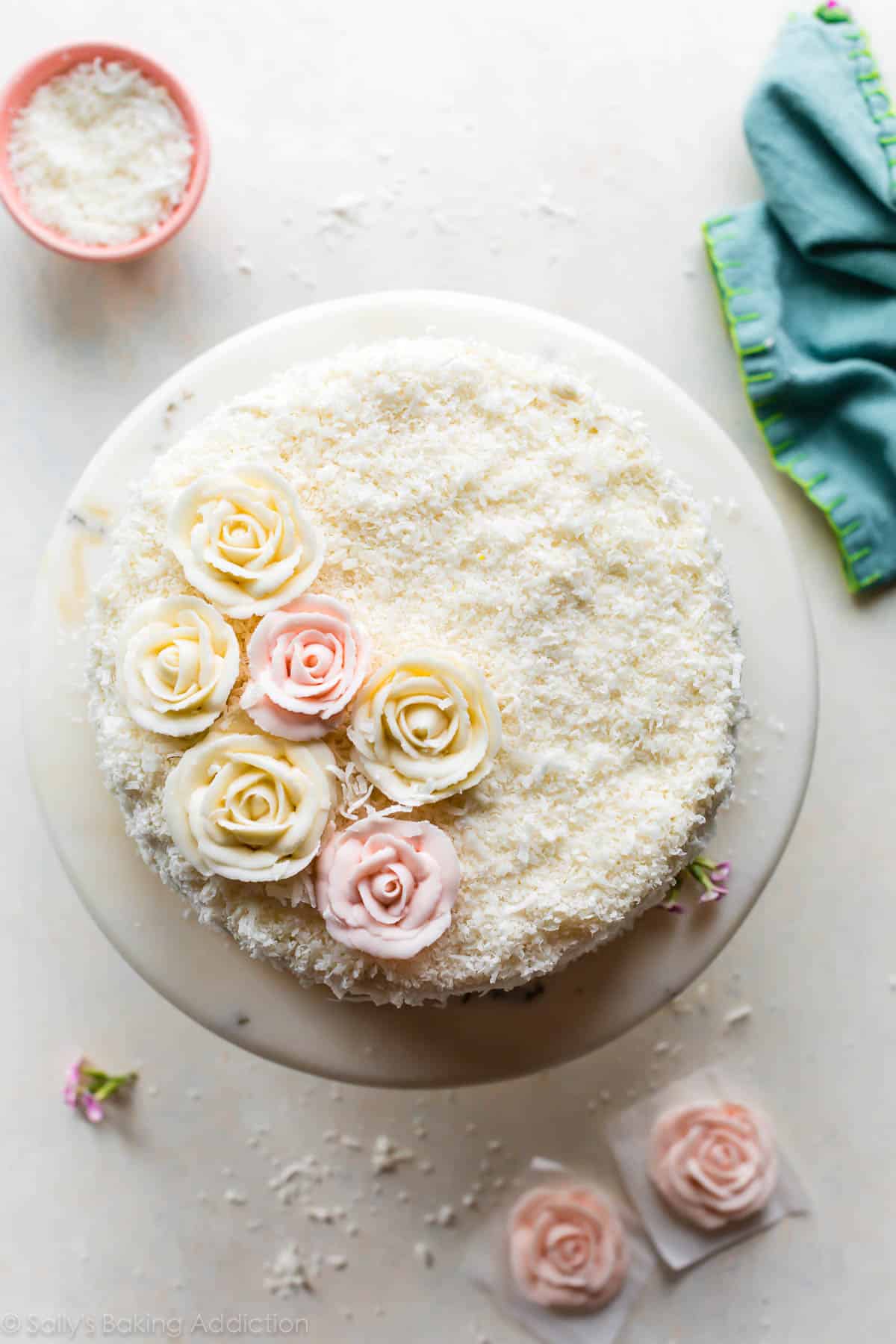
What About the Buttercream Roses?
Let’s give my assistant, Stephanie, a round of applause. This was her first time making “3D” buttercream roses and look how beautifully they turned out! She made the buttercream roses at my house and I froze them until it was time to decorate the coconut cake. She followed this video tutorial. Keep in mind that the cream cheese buttercream WILL NOT work for the intricate buttercream roses. Instead, use my vanilla buttercream and add 1 extra cup of confectioners’ sugar. You need very stiff buttercream for these roses. You also need small squares of parchment paper and:
Loosely cover the roses, then freeze or refrigerate them until ready to decorate, up to 1 week. No need to thaw prior to decorating the cake. Peel off parchment square and place the buttercream rose on the cake. If you’re traveling with the cake, I recommend securing the roses with a tiny dollop of cream cheese buttercream underneath.
Looking for something easier? Use Wilton 1M piping tip for these easy two-toned frosting buttercream roses.
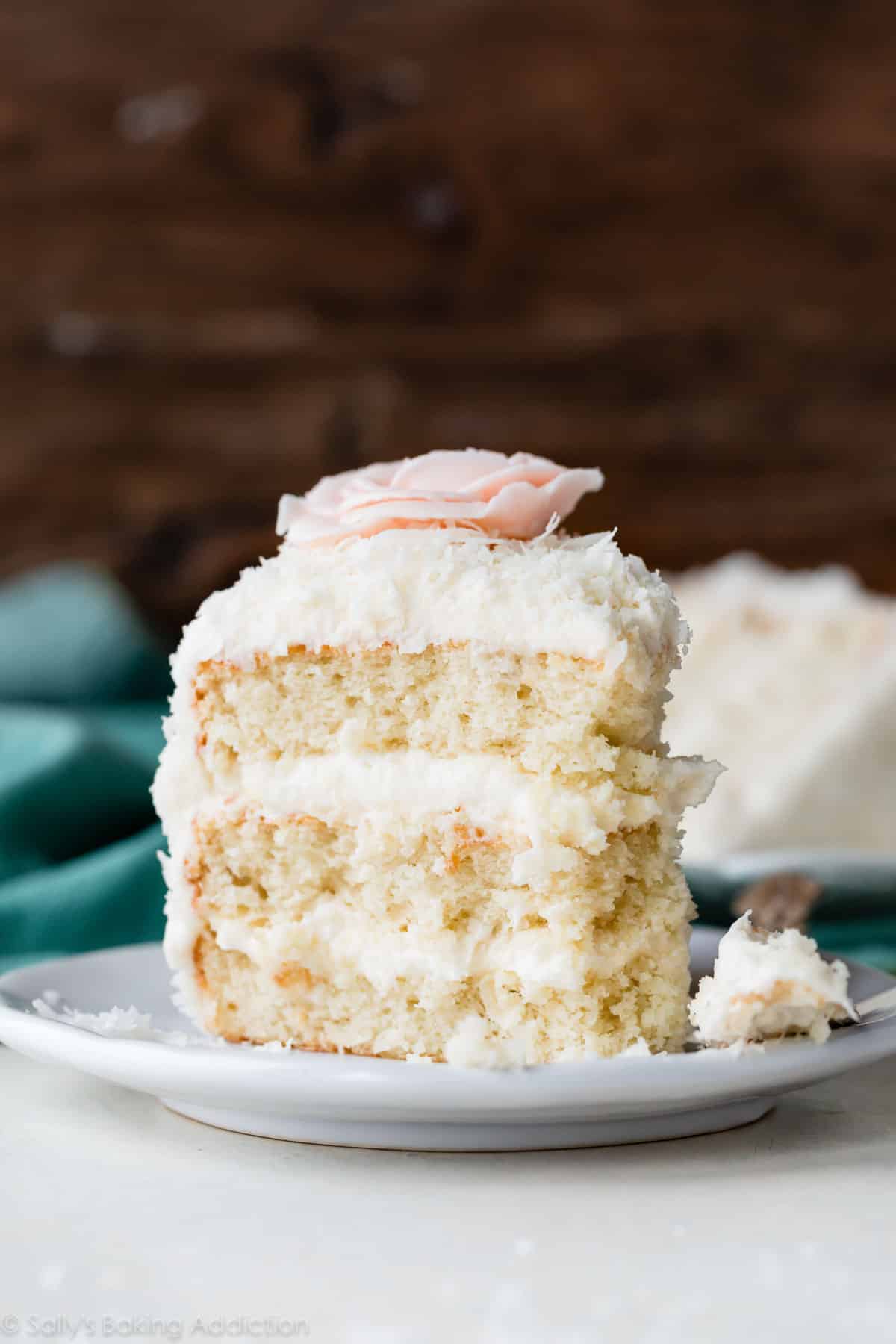
More Classic Cake Recipes
Flavor is the name, moist is the game. These are some of my favorite classic cake recipes!
- Pound Cake
- Vanilla Cake
- Carrot Cake
- Red Velvet Cake
- Strawberry Cake (made from real strawberries)
- Lemon Blueberry Cake
- Chocolate Cake
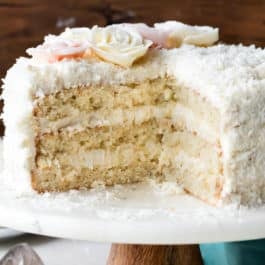
Coconut Cake
- Prep Time: 35 minutes
- Cook Time: 22 minutes
- Total Time: 4 hours
- Yield: 12 servings
- Category: Dessert
- Method: Baking
- Cuisine: American
Description
This perfect coconut cake sets the bar for homemade cakes everywhere. It’s supremely moist with a soft fluffy crumb and intense coconut flavor. For success, follow this recipe carefully including using cake flour, egg whites, sour cream, and canned coconut milk.
Ingredients
- 2 and 1/2 cups (285g) cake flour (spooned & leveled)
- 2 teaspoons baking powder
- 1/2 teaspoon baking soda
- 1 teaspoon salt
- 3/4 cup (12 Tbsp; 170g) unsalted butter, softened to room temperature
- 1 and 2/3 cups (330g) granulated sugar
- 5 large egg whites, at room temperature
- 1/2 cup (120g) sour cream, at room temperature
- 2 teaspoons pure vanilla extract
- 1 teaspoon coconut extract
- 1 cup (226g/240ml) unsweetened canned coconut milk, at room temperature*
- 1 cup (80g) sweetened shredded coconut
Coconut Cream Cheese Buttercream
- 1 cup (16 Tbsp; 226g) unsalted butter, softened to room temperature
- 8 ounces (226g) full-fat brick cream cheese, softened to room temperature*
- 5 cups (600g) confectioners’ sugar
- 2 Tablespoons (30ml) canned coconut milk
- 1/2 teaspoon pure vanilla extract
- 1/2 teaspoon coconut extract
- 1/8 teaspoon salt
- 2 cups (160g) sweetened shredded coconut
Instructions
- Preheat oven to 350°F (177°C). Grease three 8-inch cake pans, line with parchment paper rounds, then grease the parchment paper. Parchment paper helps the cakes seamlessly release from the pans. (If it’s helpful, see this parchment paper rounds for cakes video & post.)
- Make the cake: Whisk the cake flour, baking powder, baking soda, and salt together. Set aside.
- Using a handheld or stand mixer fitted with a paddle or whisk attachment, beat the butter and sugar together on medium-high speed until smooth and creamy, about 2 minutes. Scrape down the sides and up the bottom of the bowl with a rubber spatula as needed. Beat in the egg whites until combined, then add the sour cream, vanilla extract, and coconut extract. Beat until combined. Mixture will look curdled as a result of the varying textures and solid butter combining. Scrape down the sides and up the bottom of the bowl as needed. With the mixer on low speed, slowly add the dry ingredients and coconut milk. Beat on low speed until combined, then add the shredded coconut. Whisk it all by hand to make sure there are no butter lumps at the bottom of the bowl. The batter will be slightly thick.
- Pour batter evenly into cake pans. Weigh them to ensure accuracy, if desired. Bake for 21–24 minutes or until the cakes are baked through. To test for doneness, insert a toothpick into the center of the cake. If it comes out clean, it’s done. Allow cakes to cool in the pans set on a cooling rack for 1 hour, then remove from the pans and place the cakes directly on the rack to continue cooling. The cakes must be completely cool before frosting and assembling.
- Make the frosting: In a large bowl using a handheld or stand mixer fitted with a whisk or paddle attachment, beat the butter and cream cheese together on medium speed until creamy and smooth, about 2 minutes. Add confectioners’ sugar, coconut milk, vanilla extract, coconut extract, and salt with the mixer running on low. Increase to high speed and beat for 3 minutes. Add more confectioners’ sugar if frosting is too thin, more coconut milk if frosting is too thick, or an extra pinch of salt if frosting is too sweet.
- Assemble and decorate: Using a large serrated knife, slice a thin layer off the tops of the cakes to create a flat surface. Discard (or crumble over ice cream!). Place 1 cake layer on your cake stand, cake turntable, or serving plate. Evenly cover the top with 1 heaping cup (about 250–300g) of frosting. Top with second cake layer and evenly cover the top with another heaping cup of frosting. Top with the third cake layer. Spread the remaining frosting all over the top and sides. I use and recommend an icing spatula to apply the frosting and a bench scraper to smooth the sides. Sprinkle coconut on top of the cake and apply it to the sides. This can get a little messy and you can watch me do it in the video tutorial. See blog post above about buttercream rose decoration.
- Refrigerate cake for at least 20 minutes before slicing. This helps the cake hold its shape when cutting, though it’s still a pretty fluffy cake!
- Cover leftover cake tightly and store in the refrigerator for up to 5 days.
Notes
- Make Ahead & Freezing Instructions: The cake layers can be baked, cooled, and covered tightly at room temperature overnight. Likewise, the frosting can be prepared, then covered and refrigerated overnight. When ready to decorate, let the frosting sit at room temperature to slightly soften for about 15 minutes, then give it one more mix with the mixer on medium speed for about 1 minute before frosting cake. Frosted cake or unfrosted cake layers can be frozen for up to 2–3 months. Thaw overnight in the refrigerator and bring to room temperature before decorating/serving.
- Special Tools (affiliate links): 8-inch Cake Pans | Electric Mixer (Handheld or Stand Mixer) | Glass Mixing Bowls | Whisk | Cake Stand or Cake Turntable | Icing Spatula | Bench Scraper | Cake Carrier (for storing)
- Cake Flour: For the best results, I strongly recommend cake flour. You can find cake flour in the baking aisle and I have many more recipes using it. If you can’t find it, try making this cake flour substitute.
- Egg Whites: Egg whites (no yolks) are KEY to the cake’s fluffy texture. For best success, I recommend using fresh eggs instead of carton egg whites. (Using an egg separator is really handy!) Here are all my recipes using leftover egg yolks. Success tip: Eggs separate much easier when they’re cold.
- Canned Coconut Milk: Canned coconut milk is a cooking ingredient, not a beverage. It is usually unsweetened, so make sure you’re using unsweetened. It’s usually found in the grocery store near the Thai food products. Do not use refrigerated carton coconut milk beverage. You need 1 cup for the cake, not the entire can. You use 2 more Tablespoons in the frosting.
- Sweetened Shredded Coconut: I recommend using sweetened shredded/flaked coconut. It’s moister than unsweetened coconut and that makes a big difference in the cake’s texture. If desired, pulse the coconut shreds in a food processor to chop them up so they aren’t as long inside and outside of the cake. Chopping the coconut is optional.
- Cream Cheese: Use brick cream cheese, not cream cheese spread. If desired, you can use this vanilla buttercream instead (no cream cheese). Use canned coconut milk instead of milk and add 1/2 teaspoon coconut extract.
- 9×13-Inch Sheet Cake: Simply pour the batter into a greased and lightly floured 9×13-inch pan and bake for 40 minutes or until a toothpick inserted in the center comes out clean.
- 2-Layer Cake: Prepare two 9-inch cake pans in step 1. Divide batter between pans and bake for 24–26 minutes or until a toothpick inserted in the center comes out clean.
- Bundt Cake: This cake batter will fit into a greased 10-cup or larger Bundt pan. I’m unsure of the exact bake time (likely around an hour); use a toothpick to test for doneness. Same oven temperature.
- Cupcakes: Fill cupcake liners 2/3 full. Bake at 350°F (177°C) for 19–21 minutes. Yields about 2–3 dozen. Or try my vanilla cupcakes recipe and substitute canned coconut milk for whole milk, 1/2 teaspoon coconut extract for the vanilla bean, and add 3/4 cup (60g) of sweetened shredded coconut.
- Why is everything at room temperature? All refrigerated items should be at room temperature so the batter mixes together easily and evenly. Read more about the importance of room temperature ingredients.



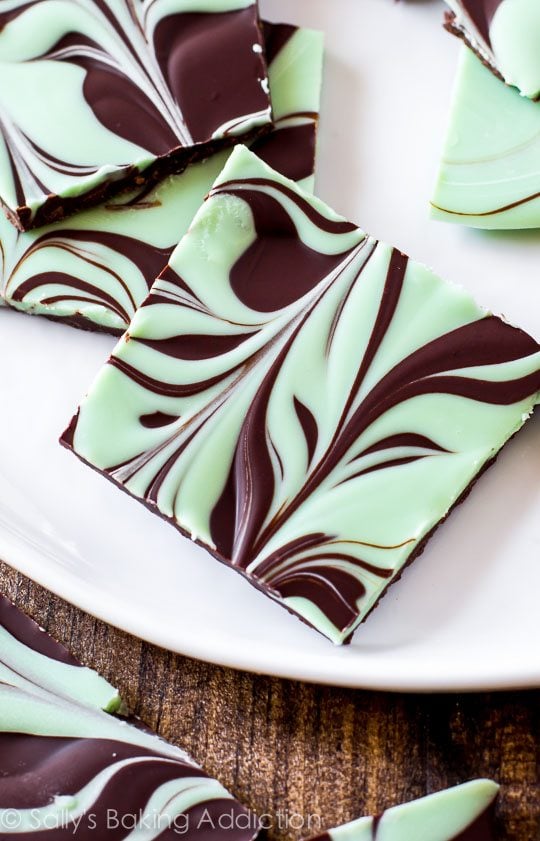













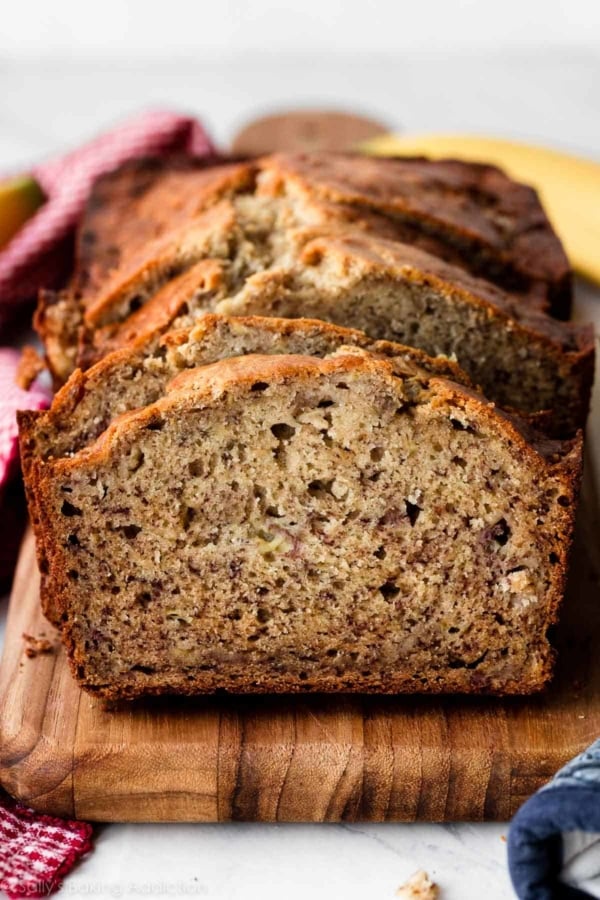

Reader Comments and Reviews
Sally’s recipes are my favorite! Question about the coconut milk-the canned coconut milk is usually separated with think cream on top and coconut milk on the bottom. Which part of the milk should be used in the cake?
Hi SueEllen, give the can a shake first to mix it all together. Happy baking!
Hi!
Planning on making this for my husband for his birthday (he LOVES coconut!)
I just want to clarify that this recipe calls for the egg ‘whites’ only??
Thank you!
That’s correct, Emily! Enjoy!
My grandson wants a coconut ice cream cake. Do you think this recipe can handle ice cream and being frozen? Thank you in advance!
Hi Leticia! This cake is quite light and fragile, so we’re unsure how well ice cream would hold up between the layers. What you might try is this ice cream loaf cake and swap the milk with full fat canned coconut milk, 1 tsp vanilla + 1 tsp coconut extract, and 1/3 cup sweetened shredded coconut instead of the sprinkles. Let us know if you try it!
Best recipe ever.
I’m a girl from the south, and I tell you that this the best coconut cake I’ve ever made. Thank you for sharing
Would I need altitude adjustments at 6600 feet?
Thank you.
Hi Ferne, we wish we could help, but we have no experience baking at high altitude. Some readers have found this chart helpful: https://www.kingarthurflour.com/learn/high-altitude-baking.html
Thank you!
Wow this cake is truly amazing my family absolutely loved this cake definitely will be making this cake again!!
I’ve made this twice now 1 8″ & 1 9″. Everyone loved them both. My question is: can I increase the recipe by 1/2 to make 3 9″ layers? I like that size cake
Hi Malcolm, sure, you could try that!
Do I have to add the coconut flakes inside the cake batter? Or can I just leave them out?
Hi Meghan, you can leave them out if you wish.
My niece has made this cake for our family and it is amazing! I’m tackling it this weekend – anything I should do for baking in a higher elevation?
Hi Kathy, We wish we could help, but have no experience baking at high altitude. Some readers have found this chart helpful: https://www.kingarthurflour.com/learn/high-altitude-baking.html
Can coconut oil be substituted for part or all of the butter?
Hi Kathleen, it can, yes, but you’ll lose a lot of buttery flavor (of course) and the texture won’t be as cakey and soft.
Is it stable enough to be a base for a two tier cake?
Hi Sarah, This cake should work well as a top and bottom tier, as long as they are properly supported. You can see all our best tips for tiered cakes in this simple homemade wedding cake recipe. Hope this helps!
This coconut cake recipe is a dream come true. I’m terrible at baking and this cake turns out moist, fluffy and perfectly balanced every time. Everyone raves and asks me to make it for them. The BEST!
Hi,
I’ve tried some of your other recipes and I’m now looking forward to trying this one. Just wondering if you have ever used unsweetened coconut flakes in this cake and/or frosting? My family doesn’t prefer a very sweet cake or frosting.
Thanks!
Hi Preeti, you can use unsweetened coconut flakes instead—the cake will still be plenty sweet!
Hiya, if I wanted to cut the recipe in half, what size tins should I use and how long to bake for?
Hi Sofia, you can halve the recipe and bake in one 9-inch round pan. Bake for 24–26 minutes or until a toothpick inserted in the center comes out clean. Enjoy!
This is truly the best coconut cake recipe and probably one of the best homemade cake recipes out there. I’ve made it several times for birthdays. I make a chantilly with coconut cream in it and use that as the frosting. I also made a mango puree filling this last time i made it. Sometimes I do strawberry or raspberry filling.
Someone told me last night the cake was moist and light and fluffy at the same time which is exactly what you want from a cake.
I’ve been craving coconut cake and this really hit the spot. Thank you ❤️
Could you use 2 to 3 whole eggs instead of egg whites?
Hi Ann, no, we don’t recommend it. We use all egg whites here for a pristinely soft crumb. Adding yolks would weigh down the batter too much.
I simply love this (Coconut cream) recipe. I made it for our group celebration of more than 40 and I think what I did was use two 12″ cake pans (round) and doubled the recipe. I was asked to do this again this year but wanted to ask your thoughts on doubling the recipe as I (think) I did previously and was great hit.
Hi Diane, double the amount of batter should be just right, although we recommend making separate batches rather than doubling (to prevent over or under mixing). Enjoy!
I only have salted butter. Can I use that in the cake?
Hi Ann, if using salted butter, you can reduce the salt added in the cake to 1/4 teaspoon. In the buttercream, taste the buttercream without any salt added and then add a pinch or two to your liking. Hope it’s a hit!
This cake is delicious! I have made it many times for family and friends. I don’t alter the recipe. It’s always a big hit and often requested. I’m looking forward to getting your cookbook for myself, nieces, and daughter-in-laws!
Hi Sally
I want to try this with 6 inch cake pans? Can you tell me how much cake batter should i make?
Hi Ridah, You can use our coconut cupcakes batter for three 6 inch cake pans. (Skip the caramel filling and chocolate frosting.) Follow the baking instructions for 6 Inch Cakes and you can halve this frosting recipe instead. Happy baking!
This cake is delicious! I’m not a coconut fan, but a dear friend’s Mom is, and she asked me to bake a coconut cake. My Baking Club recommended Sally’s Baking Addiction for a good recipe to try (they also don’t love coconut). I’ve thoroughly enjoyed sampling the leftover icing with the domed layer slices I cut off to level the layers. Yum!!!
I’m struggling to find sweetened shredded coconut (I’m from the uk) – can I use desiccated coconut instead?
I’m worried it’ll make the cake too dry
Hi Jessica! You can use desiccated coconut here with no other changes to the recipe. Hope you enjoy it!
Do I need to make any adjustments for a 3 layer cake using 8 inch pans?
Hi Alexis, yes, you can use three 8-inch pans with no changes to the recipe. The bake time will about the same for 8 inch pans, but use a toothpick to test for doneness.
Oh my goodness I made this cake for my mom‘s 90th birthday! It was absolutely spectacular and everyone who took a bite could not believe that I made it. I told them it wasn’t me it was you. Wow, you are talented!
Amazingly delicious! My son-in-law enjoys a good coconut cake, and he agreed that this recipe is a keeper. I served it to his parents, my daughter, and granddaughters, and each raved about how scrumptious it was. The crumb is moist but not dense, nor is it overly sweet. The flavorful frosting is topped with coconut, which is the perfect finish for the cake.
Hello Sally, how would I scale the recipe to make a 12×18’’ sheet cake with a height of up to 2 inches
Hi Ogoo, we have tested it in a 9×13 pan, but have not tried baking it in a 12×18 pan, so are unsure of how thick it would end up being. It may help to review this post on cake pan sizes and conversions.
Hi, I was looking to make mini champagne glass (1” tall) versions of this, so had a similar question. How thick is the cake in an 9×13”? If I baked in two 9×13” pans, would I just cut the bake time in half?
Thanks!
Hi Sarah, the single 9×13 pan may be a bit too tall for your needs. If you split between two 9×13 pans, we’re unsure of the exact bake time but keep a close eye on it and use a toothpick to test for doneness.
Hi, Is there a non-dairy substitute for sour cream in this and many other of your recipes? Kosher dietary laws don’t allow eating dairy after meat meals, so a non-dairy option opens up many recipes in all circumstances. Huge fan of your site!
Hi Bonnie! A non dairy yogurt would be a good option, but we haven’t tested it ourselves. Let us know if you try!
Hi
Is cake flour the same as Plain flour? Uk.
Hi Maryam, Depending on where you live the terms plain flour and all purpose flour are used interchangeably. It’s a white flour made from wheat, typically with a protein content between 10-12% and does not include leavening agents. If you flour matches that description you can use it.